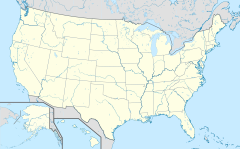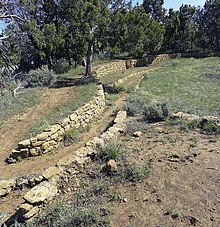Mesa Verde National Park
| Mesa Verde National Park | ||
|---|---|---|
| Spruce Tree House | ||
|
|
||
| Location: | Colorado , United States | |
| Specialty: | Anasazi rock dwellings | |
| Next city: | Cortez (Colorado) | |
| Surface: | 212.40 km² | |
| Founding: | June 29, 1906 | |
| Visitors: | 563,420 (2018) | |
| Address: |
Mesa Verde National Park Headquarters PO Box 8 Mesa Verde, CO 81330-0008 Tel. (970) 529-4465 |
|
| Cliff Palace | ||
| Square Tower House | ||
Mesa Verde (Spanish for Green Table Mountain ) is a national park in the southwestern part of the US state Colorado - about 420 kilometers southwest of Denver and about 50 kilometers west of the small tourist center Durango . The park protects around 4000 archaeological sites, especially the well-preserved rock dwellings of pre-Columbian Anasazi tribes , which were only fully explored at the end of the 19th century .
Mesa Verde is the only national park in the United States that was established to protect an archaeological site; other cultural and historical objects are designated as national monuments or in another formally lesser protected area category. In 1978, the Mesa Verde National Park was as a UNESCO World Heritage Site in the list of the United States included.
geography
Mesa Verde is a densely forested and rugged table mountain , which stands out from the surrounding landscape of southwestern Colorado by more than 600 meters and thus reaches an altitude of almost 2,600 meters at its highest points.
Research history
In 1888, Charlie Mason and Richard Wetherill, both cowboys from Mancos , searched for stray cattle and discovered the abandoned houses under deep abysses . In the following years Wetherill devoted himself to the exploration of many ruins of the Anasazi and undertook numerous excavations. After Gustaf Nordenskiöld, a Swedish researcher, had sent around 600 remains to Sweden, what is now the most historically significant national park in the United States was established on June 29, 1906 to protect the Anasazi settlements. It was added to the UNESCO World Heritage List on September 6, 1978 .
Archaeological history
The Mesa Verde region had been more populated since about AD 600. People living in villages consisting of a few pit houses (engl. Pit houses) on the flat surface of the mesas. Since the settlements in the area emerged much earlier, one must assume that the mesa areas only became attractive at this time. Unlike today, they offered regular rain, fertile soil and a lot of wood from the forests. There was also plenty of game and constant springs. Around 750 the pit houses were increasingly abandoned and people built superficial houses with wicker walls between vertical posts, which were then clad with clay. Obviously these constructions failed, so the use of stone material began to be preferred and the complexes of masonry living quarters and storerooms known as pueblos began to be built, which eventually assumed considerable sizes and accommodated up to 500 people. The traditional semi-underground pit houses were retained as ceremonial rooms, the kiva, accessible through the roof via a ladder.
The use of the abrises in the steep rock walls of the canyons did not begin until late, around 1200 AD. It is controversial in research why this change in settlement practice occurred in the first place, as it comprised perhaps half of the population of Mesa Verde. For that reason alone reasons of defense are ruled out.
The Anasazi - whose buildings were first discovered by the Navajo around the 16th century and from whom they received their common name today - reached their cultural peak during this time. Even if, despite decades of excavations and research, the entire history of the Anasazi who lived on Table Mountain can no longer be clearly and completely reconstructed, objects found allow some conclusions to be drawn about their everyday lives. The residents of Mesa Verde were excellent potters and basket makers ; In addition to pots, drinking vessels and ladles, their products also included items that were probably used for ceremonial purposes. It is assumed that the craft was practiced mainly by women and that the skills were passed on from mothers to daughters. In this heyday, the pottery was decorated with geometric structures. There are also relatively simple examples of rock engravings depicting human shapes.
The Anasazi already had excellent irrigation systems at their disposal, which helped them to grow corn, beans and peppers. Mummy Lake, which forms part of Far View, has long been an example of a reservoir. Another source of food was the men's hunt, which must have been arduous due to the height differences to be overcome through the rugged Mesa Verde.
Soon after the establishment of the cliff dwellings, slow depopulation began. The reasons are still unclear. Perhaps an increasing drought also played a role, peaking between 1275 and 1299. It worsened living conditions such as cultivation, logging and hunting, as can be demonstrated by the increasingly critical diet. By 1300 AD the Mesa Verde area was practically deserted.
Cliff dwellings
The attraction of Mesa Verde is made up of around 600 rock dwellings, of which only around a dozen formed larger settlements and are now as famous as the Spruce Tree House , Balcony House or Cliff Palace .
Cliff Palace
The Cliff Palace is one of the largest settlements in the Mesa Verde area. These rock houses (according to Baumring dating ) have been built from sandstone blocks in an overhanging abri since around 1190 AD, which were connected with mortar made from earth, water and ash. Wooden beams were used to construct ceilings and doorways. The construction time is short, essentially 20 years, with less activity until 1260 AD. The Cliff Palace was abandoned as early as 1300 AD. The Cliff Palace has around 150 rooms and 23 kivas . The number of residents should not have been more than 100.
A remarkable construction is a rectangular tower with four floors that almost reaches the roof of the Abri, it has been partially reconstructed. Other tower-like structures are round and lower in height.
Buildings on the area of the mesa
Originally the Anasazi colonized the surface of the mesa. Their history of settlement in the region began with simple pit houses and developed into pueblos before they built the extensive Cliff Palaces in the rock overhangs.
On Chapin Mesa , several structures on the surface have been preserved or restored and are accessible to visitors. Including the Far View Complex and the Mesa Top Sites at the top of Chapin Mesa .
Mesa Top Sites
Buildings from different epochs of the settlement history can be reached on the ledge, which is the top of the almost 10 km long Chapin Mesa . A settlement complex includes the excavation site of a pit house and a reconstructed building from the first stage of development of the pueblos. Further to the east are Sun Point Pueblo and Sun Temple, two buildings from the previous era of Mesa Verde and only partially reconstructed. Sun Temple was a place for settler community ceremonies.
Far View
The Far View Complex is roughly in the middle of Chapin Mesa . It consists of a medium-sized and a smaller pueblo from the middle epoch of Anasazi history. A large communal kiva has been found in the immediate vicinity, but it has not yet been excavated.
A little north of the complex is a large, circular structure around 27 meters in diameter, which was previously regarded as a water reservoir and was therefore called Mummy Lake ( Mummy Lake ) and later Far View Reservoir (Far View Reservoir) by the original excavators . Analyzes published in 2014 showed that the alleged water supply lines of the reservoir could not conduct water due to the structure of the terrain. In addition, rainwater that would have run down the slopes in the assumed catchment area would inevitably have blocked the construction with alluvial sand and clay particles. The new interpretation sees the structure as a ceremonial place and the alleged canals as ritual processional streets modeled on the nearby Chaco Canyon culture .
Registration as a world heritage site
| Mesa Verde National Park | |
|---|---|
|
UNESCO world heritage |
|
| National territory: |
|
| Type: | Culture |
| Criteria : | (iii) |
| Surface: | 21,043 ha |
| Reference No .: | 27 |
| UNESCO region : | Europe and North America |
| History of enrollment | |
| Enrollment: | 1978 ( session 2 ) |
In 1978 the Mesa Verde National Park was entered on the list of UNESCO World Heritage Sites as the first world heritage site in the United States based on a resolution of the second session of the World Heritage Committee. At the meeting, Yellowstone National Park was also included as the first world natural heritage site.
The world heritage site covers an area of 21,043 hectares.
The reason for the entry states, among other things:
The Mesa Verde Landscape is a remarkably well-preserved prehistoric settlement landscape of the Anasazi culture that lasted for almost 900 years from around 450 to 1300. This plateau in southwest Colorado, at an altitude of more than 2,600 meters, contains a large concentration of spectacular Pueblo Indian dwellings, including the well-known rock dwellings. This rich landscape offers a remarkable archeological laboratory to enhance our understanding of the Anasazi.
The entry was made on the basis of criterion (iii).
(iii): The extraordinary archaeological sites of the Mesa Verde landscape testify to the ancient cultural traditions of the Indian tribes. They represent a vivid connection between the past and present of the Pueblo peoples of the American Southwest.
Others
On October 15, 1966, the national park was added to the National Register of Historic Places as a Historic District . Some National Park Service buildings within the national park were given National Historic Landmark status on May 29, 1987 as the Mesa Verde Administrative District . The alleged reservoirs and irrigation systems were added to the List of Historic Civil Engineering Landmarks by the American Society of Civil Engineers in 2004 .
literature
- Ricardo Torres-Reyes: Mesa Verde National Park - An Administrative History - 1906-1970. National Park Service 1970 (English) ( online )
- Linda S. Cordell: Prehistory of the Southwest . Academic Press, Orland, 1984, ISBN 0-12-188220-9
- David Grant Noble: Ancient Ruins of the Southwest . Northland Publishing, Flagstaff, 1996, ISBN 0-87358-530-5
Web links
- National Park Service: Mesa Verde National Park (official site; English)
- US National Parks Net: Mesa Verde National Park (English)
- Archaeologist in Mesa Verde National Park (University of Pennsylvania) (English)
- Entry on the UNESCO World Heritage Center website ( English and French ).
Individual evidence
- ↑ LV Benson, ER Griffin, et al .: Mummy Lake: an unroofed ceremonial structure within a large-scale ritual landscape . In: Journal of Archaeological Science , Volume 44, April 2014, pages 164-179, doi: 10.1016 / j.jas.2014.01.021
- ↑ Decision - 2 COM VIII.38. UNESCO World Heritage Center, 1978, accessed March 24, 2019 .
- ↑ a b c Entry on the website of the UNESCO World Heritage Center ( English and French ).
- ^ Mesa Verde National Park in the National Register Information System. National Park Service , accessed July 29, 2017.
- ^ Mesa Verde Administrative District on the National Register Information System. National Park Service , accessed July 29, 2017.
- ↑ Listing of National Historic Landmarks by State: Colorado . National Park Service , accessed July 29, 2017.









